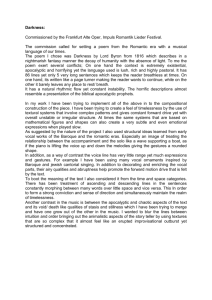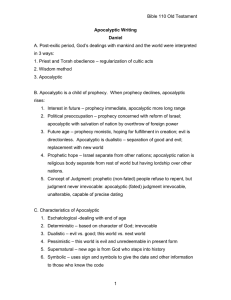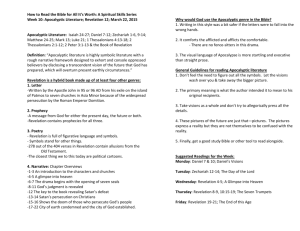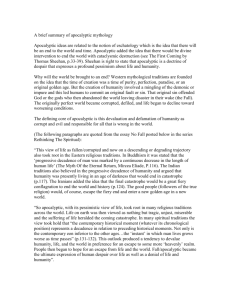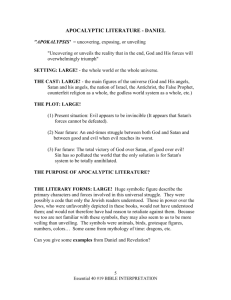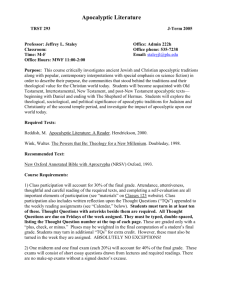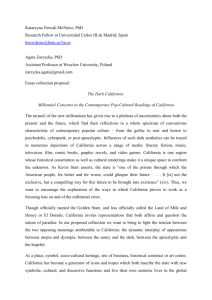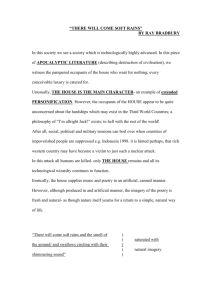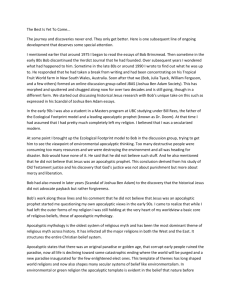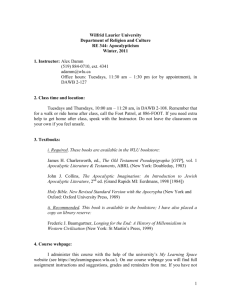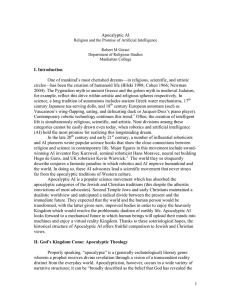The End is Near: Appreciating Apocalyptic By Peter N. Riefstahl The
advertisement
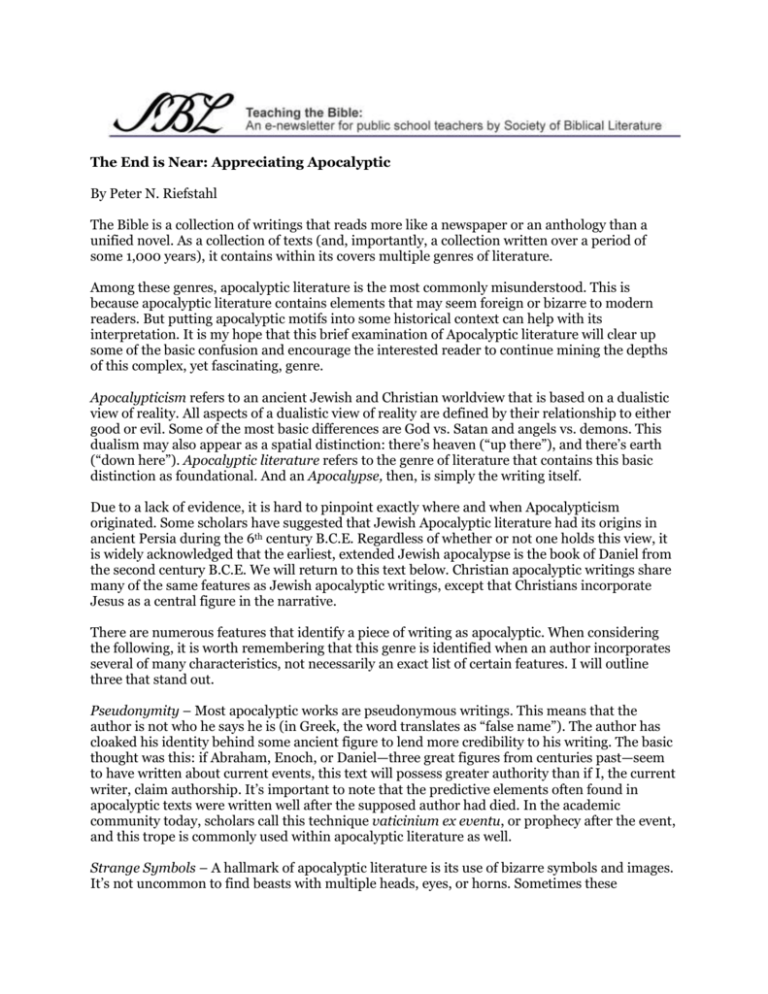
The End is Near: Appreciating Apocalyptic By Peter N. Riefstahl The Bible is a collection of writings that reads more like a newspaper or an anthology than a unified novel. As a collection of texts (and, importantly, a collection written over a period of some 1,000 years), it contains within its covers multiple genres of literature. Among these genres, apocalyptic literature is the most commonly misunderstood. This is because apocalyptic literature contains elements that may seem foreign or bizarre to modern readers. But putting apocalyptic motifs into some historical context can help with its interpretation. It is my hope that this brief examination of Apocalyptic literature will clear up some of the basic confusion and encourage the interested reader to continue mining the depths of this complex, yet fascinating, genre. Apocalypticism refers to an ancient Jewish and Christian worldview that is based on a dualistic view of reality. All aspects of a dualistic view of reality are defined by their relationship to either good or evil. Some of the most basic differences are God vs. Satan and angels vs. demons. This dualism may also appear as a spatial distinction: there’s heaven (“up there”), and there’s earth (“down here”). Apocalyptic literature refers to the genre of literature that contains this basic distinction as foundational. And an Apocalypse, then, is simply the writing itself. Due to a lack of evidence, it is hard to pinpoint exactly where and when Apocalypticism originated. Some scholars have suggested that Jewish Apocalyptic literature had its origins in ancient Persia during the 6th century B.C.E. Regardless of whether or not one holds this view, it is widely acknowledged that the earliest, extended Jewish apocalypse is the book of Daniel from the second century B.C.E. We will return to this text below. Christian apocalyptic writings share many of the same features as Jewish apocalyptic writings, except that Christians incorporate Jesus as a central figure in the narrative. There are numerous features that identify a piece of writing as apocalyptic. When considering the following, it is worth remembering that this genre is identified when an author incorporates several of many characteristics, not necessarily an exact list of certain features. I will outline three that stand out. Pseudonymity – Most apocalyptic works are pseudonymous writings. This means that the author is not who he says he is (in Greek, the word translates as “false name”). The author has cloaked his identity behind some ancient figure to lend more credibility to his writing. The basic thought was this: if Abraham, Enoch, or Daniel—three great figures from centuries past—seem to have written about current events, this text will possess greater authority than if I, the current writer, claim authorship. It’s important to note that the predictive elements often found in apocalyptic texts were written well after the supposed author had died. In the academic community today, scholars call this technique vaticinium ex eventu, or prophecy after the event, and this trope is commonly used within apocalyptic literature as well. Strange Symbols – A hallmark of apocalyptic literature is its use of bizarre symbols and images. It’s not uncommon to find beasts with multiple heads, eyes, or horns. Sometimes these appendages are applied to commonplace animals such as goats or rams. At other times, these physical anomalies appear on creatures made up of improbable combinations of lion’s mouths, bear’s feet, and a leopard’s body. Occasionally these depictions symbolize earthly rulers or powers whom the attentive reader can determine based on contextual clues; while on other occasions they predict the coming of a power, as yet undisclosed, that is so horrible it can only be described in the most gruesome of details. Crisis and Catharsis – This apt phrase, coined by New Testament scholar Adela Yarbro Collins, sums up perhaps the most important aspect of apocalyptic literature. These writings spoke to pious individuals and communities who were experiencing suffering at the hands of their enemies. The texts typically emphasized a contemporary “crisis” for those believers who had grown complacent in their faith, believers who required a reminder that the end is not yet and that the battle against the enemy—be it Greece, Rome, or some spiritual power—must continue until God intervenes. Conversely, the “cathartic” element speaks to those who are well aware of the battle at hand, and need to be reminded that God is still in control and will resolve all things accordingly. Apocalyptic literature regularly employed all of these features, and a few others, within the same pages. Of the various apocalyptic texts written in antiquity, only the book of Daniel was incorporated into the Tanakh, or Old Testament. Of its 12 chapters, only the latter six truly exemplify an apocalyptic style. The first six chapters can be described as “court tales,” much like the story of Joseph in Genesis 37-50. Although Daniel is the primary figure throughout the text that bears his name, a noticeable shift occurs in chapter seven, when Daniel changes from being merely an actor in the narrative to becoming the main character. He is no longer spoken of in the third person, but he speaks in the first person, as the one narrating these events as they happen. In chapter 8, speaking in cryptic language (of a ram with two horns and a male goat from the west, for example), the pseudonymous “Daniel” records various “future” events that appear to him in a vision. The first of his obscure predictions in this chapter is known to refer to the fourth century B.C.E. general-king Alexander the Great, who meets an untimely end in 323 B.C.E. (his great horn is broken – Daniel 8:8a) and his empire is divided to four of his generals (toward the four winds of heaven – Dan. 8:8b). From here Daniel moves immediately to contemporary concerns, speaking of a little horn that will arise against heaven and earth (Dan. 8:9). This little horn, a Greek king named Antiochus IV Epiphanies, rules over Palestine in the mid-2nd century B.C.E. and is the catalyst for the persecution of many Jews. The actual author uses predictive language, as though Daniel were recounting these visions centuries prior, to legitimate the view that with the coming of this well-known, horrendous power, the “time of the end” (Dan. 8:19) is very near and a divinely ordained overthrow is at hand. He writes to comfort those who hear his message, proclaiming that God himself will intervene to overthrow this antagonistic figure (“He shall be broken, and not by human hands” in Dan. 8:25b). However, Daniel is told to seal up this prediction (another common characteristic, seen in Dan. 8:26), and once the appointed time arrives, the message will be revealed and the faithful will know that its words are true because they will all see God’s power on display. The New Testament includes only one example of apocalyptic writing—the final book, Revelation. Some Bibles title this text the “Apocalypse,” based on the first word of the book. The word apocalypse literally means a revealing or making known of something previously undisclosed. After a brief introduction, in which the author, John, addresses his writing to seven churches in western Asia Minor (modern day Turkey) the reader quickly enters into a grand vision of the heavenly throne room, in which we find God seated on his throne, along with his divine council. Creatures with multiple eyes and multiple wings continually sing God’s praises. Throughout the next several chapters, one finds numerous, graphic depictions of the terrible fate that awaits the earth and its inhabitants. Global, cataclysmic disasters befall mankind. For those who remain faithful to Jesus’ teachings even amidst suffering, a place of eternal bliss awaits them after the earth’s destruction. For those who have ignored Jesus’ message of salvation, only darkness and torment await. In particular, those most strongly condemned are the ones who have sided with the arch-nemesis of the church “Babylon,” the codename for Rome. In the final chapters, John wraps up his cathartic vision for the believers whose names are written in the “Lamb’s book of life.” (The “Lamb” is code for Jesus.) If one’s name is found recorded in this distinguished Who’s Who of the saints, one is granted admission to a new celestial city with streets of gold. Conversely, an eternal lake of fire and sulfur stands ready to welcome any who have turned their backs on this divine message. Combining cryptic messages of horned beasts, cataclysmic events, and language of secrecy, the book of Revelation serves as an excellent example both of Christian Apocalyptic literature and of how some first century Christians viewed themselves in relation to the broader Roman Empire. Certainly other texts, such as the Apocalypse of Peter, which looks a bit like an early version of Dante’s Inferno, could be examined, but unfortunately this is where we must leave off. These various elements combine to form one of the most fascinating though quite commonly misunderstood genres of literature found within the Bible. With a bit of investigation, the interested and attentive reader can decode much of the mystery behind apocalyptic literature by properly interpreting these texts within their historical contexts. Peter Riefstahl holds the Master of Divinity from Gordon-Conwell Theological Seminary, teaches part-time at Mercyhurst University. For Further Reading Adela Yarbro Collins, Crisis and Catharsis: The Power of the Apocalypse. Louisville: Westminster John Knox Press, 1984. John J. Collins, The Apocalyptic Imagination: An Introduction to Jewish Apocalyptic literature, Revised Edition. Grand Rapids: Eerdmans Publishing Company, 1998. See also related articles in Teaching the Bible: Form Criticism: www.sbl-site.org/assets/pdfs/TB6_FormCriticism_JJ.pdf Genre in the Bible: www.sbl-site.org/assets/pdfs/TBRecognizingGenre_RF.pdf Definition: Tanakh: This word is an acronym for the three parts of the Jewish Bible, commonly known as the Old Testament. The three divisions are: Torah (Teachings or Law; = Pentateuch); Nevi’im (Prophets); and Ketuvim (Writings). The first letter of each of these words are used to create the acronym Tanakh.
